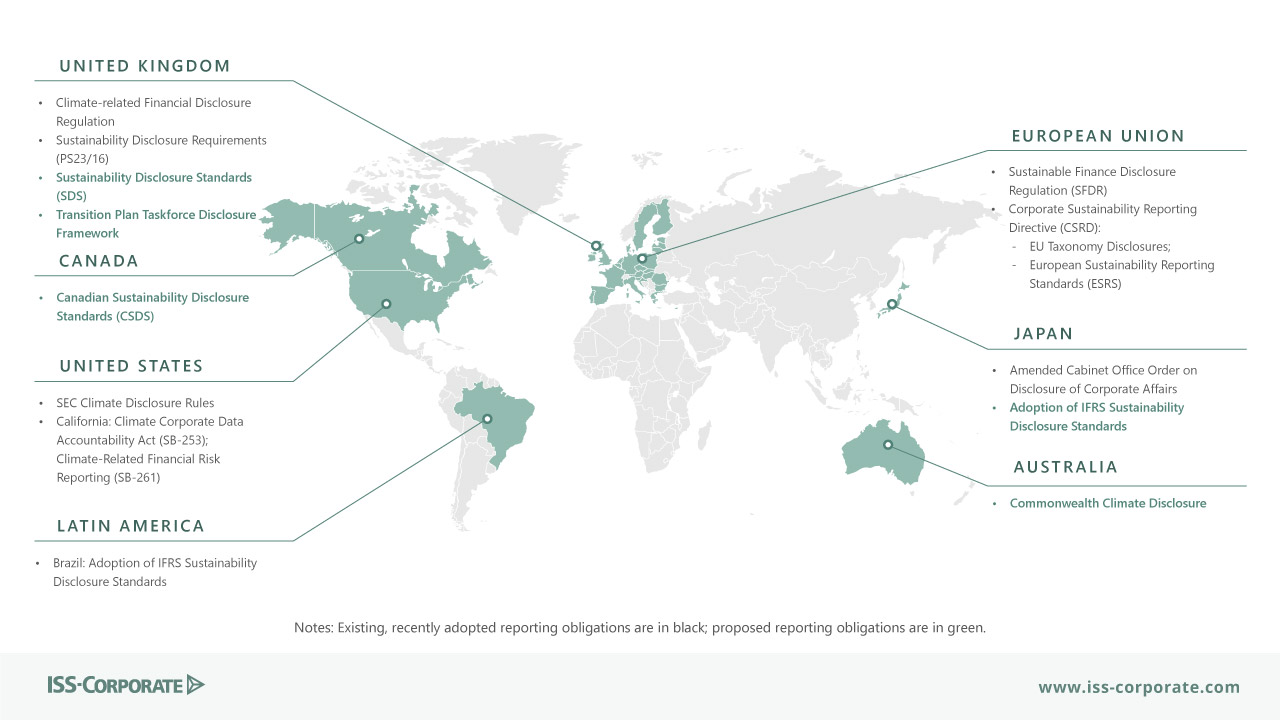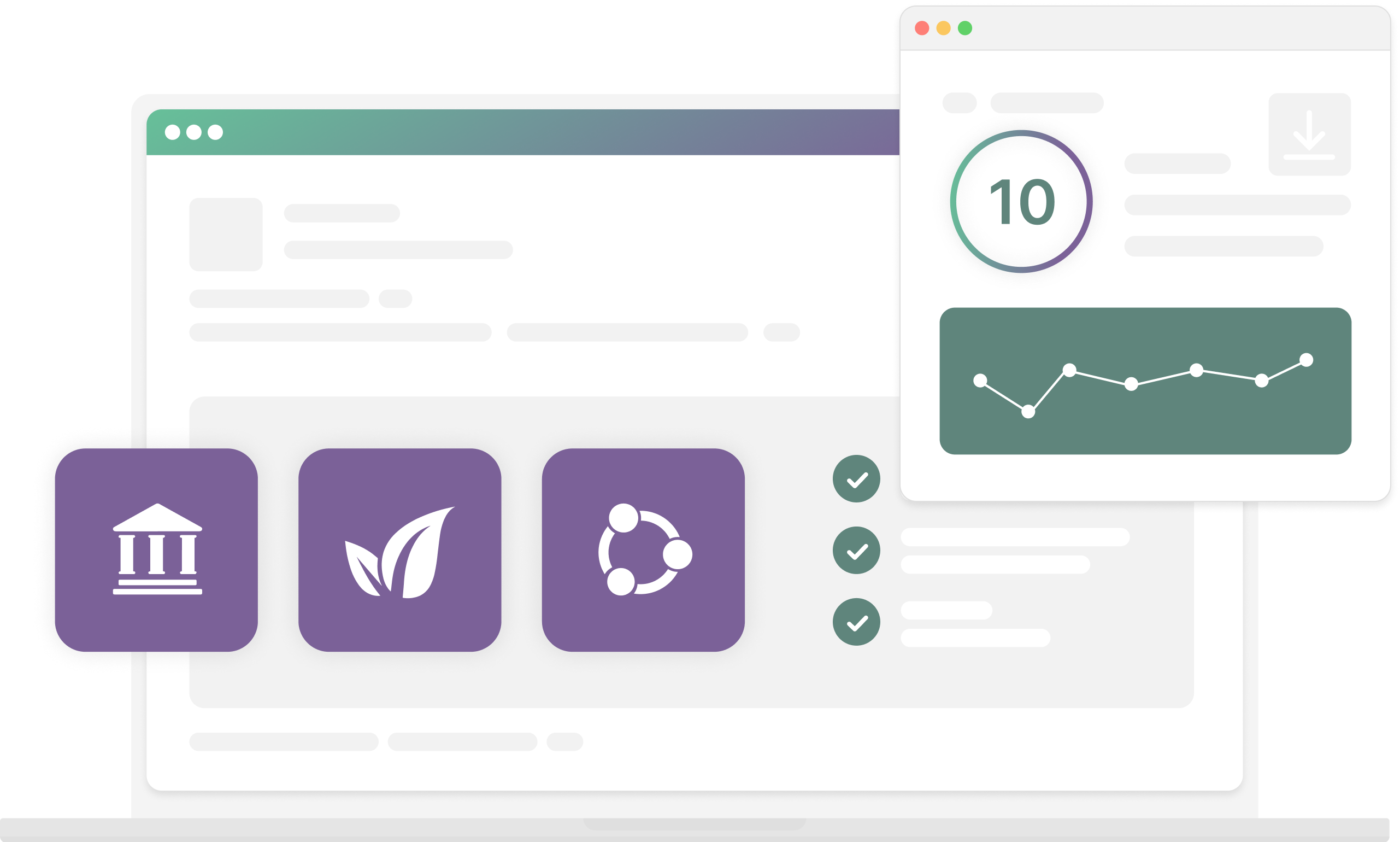A Global Baseline? How to Navigate Interoperability Across Sustainability Reporting Rules

Sustainability reporting rules developed by the International Sustainability Standards Board (ISSB) for the IFRS Sustainability Disclosure Standards are set to be adopted across jurisdictions in the next few years, establishing a global baseline for corporate disclosures. This represents an opportunity for companies to harmonize their sustainability data in a complex regulatory environment. Adopting these new standards as early as possible and understanding their interoperability with other regulations are crucial considerations for sustainability leaders.
Adoption pathways will vary across jurisdictions, from full immediate to partial or phased adoption. Climate disclosures have been designated the highest priority by the ISSB and national regulators globally. The ISSB will take over responsibility this year for monitoring implementation of the recommendations of the Task Force on Climate-Related Disclosures (TCFD), which have defined climate reporting globally since the release of their guidelines in 2017 . Gaining an early understanding of the further evolution of climate reporting under the TCFD-based IFRS S2 is critical for companies.
Companies already reporting in line with the TCFD recommendations will have to enhance their climate disclosures to account for ISSB’s requirement, with more detailed information about material climate-related risks, transition plans and resiliency, as well as industry-based metrics and mandatory Scope 3 GHG emissions reporting.
Comparing the ISSB Global Baseline with Europe’s Regional Requirements
Anticipating the compatibility of sustainability disclosures compliant with ISSB-based jurisdictional law and the EU’s Corporate Sustainability Reporting Directive (CSRD) (read ISS-Corporate’s commentary ESRS: A New Chapter in Sustainability Reporting) will be of highest priority for non-EU companies with significant operations or business and financial ties to the EU.
CSRD is the most ambitious sustainability disclosure requirement to date, covering a comprehensive scope of sustainability topics. The topics against which captured organizations need to disclose are determined by the performance of a double materiality assessment, highlighting the most relevant sustainability areas. This approach demands that companies identify and evaluate both their impact on people and the environment and the effect on their financial performance, along the full value chain. CSRD disclosures are designed for use by a wider group of stakeholders beyond investors.
The expanded scope of CSRD means that EU companies with business ties in jurisdictions covered by ISSB that are already making CRSD-compliant disclosures (according to the European Sustainability Reporting Standards, ESRS), including those related to climate change, should in principle satisfy any non-EU requirements. It is worth noting that ESRS sector-specific guidance is yet to be developed. The Global Reporting Initiative (GRI) and Sustainability Accounting Standards Board (SASB; now part of ISSB) will continue to play an important role.
Companies with global operations and value chains will have to address the question of interoperability of sustainability reporting rules beyond the comparison between the ISSB and CSRD. For U.S. companies and companies with significant business ties to the U.S., existing and imminent climate disclosure requirements are in focus. The U.S. Securities and Exchange Commission voted on March 6 on the adoption of long-anticipated climate-related disclosure rules requiring all U.S. public companies to make additional climate-related disclosures, largely based on the recommendations of TCFD but also requiring the disclosure of emissions and climate-related financial information in the financial statements.
The California legislature in October 2023 pressed ahead with two climate disclosure bills (read ISS-Corporate’s recent overview of California Senate Bills 261 and 253). The rules will require increased climate disclosure for companies “doing business” in California. These are the Climate Corporate Data Accountability Act (SB 253) for Scope 1, 2 and 3 GHG emissions disclosure, and the Climate Related Financial Risk Act (SB 261) aligned with TCFD. Whilst the first California climate disclosure is expected in January 2026, both these and the SEC rules are currently subject to significant ongoing legal challenges.
Sustainability Due Diligence on the Rise
Several jurisdictions have passed or are considering sustainability due diligence legislation with varying scope. Next to the recent regulations in California, the United Kingdom, Australia and France, the more recent legislative initiatives in Germany (German Supply Chain Act) and Canada (Bill S-211), have an impact beyond their immediate jurisdictions.
With these mounting regulations, there is a clear imperative for companies to prepare in advance for legal compliance and, in equal measure, stakeholder expectations. Individually the ISSB, CSRD, SEC Climate and other regulations will require considerable focus for reporting companies. Many companies will have to abide by multiple regulatory regimes in each reporting cycle in the coming years. The question of where disclosure requirements align or differ is crucial for designing a resource-efficient approach to sustainability reporting.
How can Companies Take Advantage of Regulatory Interoperability?
Recognizing these challenges, standard setters have examined potential efficiencies and obstacles across rules. Recently, EFRAG, the technical advisor to the European Commission, publicly endorsed the ISSB climate reporting requirements, noting that they are already incorporated within ESRS. The ISSB, which incorporated the SASB from its outset, also agreed to coordinate work programs and standard-setting activities in a memorandum of understanding with the GRI. EFRAG and GRI also announced increased collaboration with deeper ties in November 2023.
There are considerations for companies when it comes to regulatory efficiencies and obstacles:
Understanding where regulations are aligned, and where they differ, to avoid duplicating efforts for common disclosure areas, such as climate.
- Designing one operating model to comply with multiple regulations, especially for companies captured by several regulatory regimes, with different phase-in requirements.
- Having adequate capacity and expertise to comply with multiple regulations. Companies will need to be confident that they have both the bandwidth to deal with the demands of new regulations, as well as the right skill set for specialized areas, e.g., Scope 3 emissions or biodiversity.
- Support for different approaches to materiality, including the Double Materiality Approach required by CSRD.
- The ability to gather and process new data to fulfill requirements (including value chain data).
Readiness for different levels of sustainability assurance required across regulations. Assurance over ISSB will likely differ by jurisdiction, whilst CSRD requires limited assurance from the first reporting year for all undertakings. The SEC Climate rule is expected to introduce a phased approach to assurance, initially exempting Scope 3 emissions. - Designing robust governance, processes and controls to support implementation, particularly as the quality of these is likely to be scrutinized under the applicable assurance engagements.
However, there are opportunities for companies that take a proactive approach:
- Companies that understand overlapping disclosure topics can find efficiencies in their reporting processes.
- Early adopters of new sustainability regulations can develop disclosure processes before rules are effective in their jurisdictions, mitigating the risks of non-delivery, and preparing for independent assurance.
- Companies that harness regulatory interoperability can enjoy an improved reputation among stakeholders, increasing their access to capital from diverse investors who want transparent and comprehensive sustainability data on investee companies.
- Companies that effectively report against several regulations will be favorably benchmarked and evaluated against their peers.
As CSRD represents the most comprehensive sustainability reporting framework to date, ambitious organizations beyond its scope of applicability will see it as their north star.
Harmonization of Corporate Sustainability Disclosures

Source: ISS-Corporate
What should proactive companies consider?
Below, we have summarized five focus areas for companies examining the interoperability of sustainability regulations:
1. What are the current efforts to ensure a high level of interoperability across standards?
- ISSB and ESRS, as well as national climate disclosure rules are based on the recommendations of TCFD.
- ISSB builds on the work of earlier initiatives, most importantly SASB and the Integrated Reporting Initiative.
- EFRAG and GRI announced increased collaboration with deeper ties in November 2023.
- The IFRS Foundation and the GRI have published an analysis of interoperability considerations for GHG emissions disclosures, including a mapping between standards.
- The European Commission and EFRAG published a paper assessing the interoperability between the ESRS General and Climate disclosures with IFRS S1 and S2, providing a mapping table.
- All companies disclosing through CDP (18,700 companies) will be asked to disclose in line with the ISSB climate standard.
2. Why are there differences across standards and jurisdictions?
- Achieving 100% alignment across regulations has not been the objective for standard setters.
- Regulations are intended for different primary users. For example, the IFRS Sustainability Disclosure Standards are investor-focused, whilst CSRD considers wider users of sustainability disclosures.
- Jurisdictions will choose different regulation adoption pathways. For example, with ISSB this could impact the initial year that rules are phased in, whether they apply all the rules from the beginning or start with just climate, and whether they are voluntary or mandatory in the first reporting years.
- New regulations are more ambitious, requiring more detailed, specific information.
3. Climate first
- Climate continues to be a focal point for standard setters, and therefore a key focus area for efforts to ensure a high level of interoperability.
- IFRS S2, ESRS E1 and the proposed SEC Climate (S-K) regulations are all largely influenced by the recommendations and structure of the TCFD. This should help companies find efficiencies, especially where climate disclosures are already aligned to TCFD.
- IFRS S2, ESRS E1 and the proposed SEC Climate (S-K) regulations all introduce requirements for disclosure of Scope 3 GHG emissions, with various phase-ins.
4. Materiality across standards
- Companies conducting materiality assessments should consider the nuances in how these should be executed under key regulations, i.e., ISSB and CSRD.
- The new ISSB standards require an entity to disclose financially material sustainability information. That means data on sustainability-related risks and opportunities that could reasonably be expected to affect the company’s prospects, its cash flows, access to finance or cost of capital over the short, medium or long term. Therefore, disclosures should meet the information needs of investors.
- CSRD requires a double materiality approach: impact of company activities and conduct on people and the planet, along the full value chain, as well as the financial effect of social and environmental matters, for wider users of sustainability disclosures. The comprehensive approach for the European standard will largely fulfill the materiality requirements of other regulations.
5. No regrets actions: early adoption vs regulatory imperative
- The regulatory direction of travel is clearly towards increasingly robust sustainability reporting requirements. Companies that act now will benefit from early progress towards looming reporting deadlines, avoiding potential delays caused by operational constraints.
- Companies aligning to standards early will have more transparent and comprehensive disclosures aligned with the demands of a diversified base of investors and financial partners.
- Early adopters will benefit from additional time to understand their material topics and develop the appropriate metrics, processes and controls to report on those topics, with future assurance requirements in mind.
- Early adopters will find it easier to retain and attract talent. Existing and prospective employees seeking greater purpose in the workplace want to know that employers are taking steps to mitigate the potential negative impacts on the climate and society, and indeed striving to make positive impacts.
- Conversely, companies that wait until there is a regulatory imperative for alignment may miss out on some of the opportunities outlined above.
A Global Baseline? How to Navigate Interoperability Across Sustainability Reporting Rules
Due Diligence: A Core Concept Underpinning the CSRD Framework
Are European Companies Ready for Scope 3 Disclosures?
ESRS: A New Chapter in Sustainability Reporting
Shareholder Resolutions in Review: Political Spending
Women’s History Month: Female Chairs
Women’s History Month: Female CEOs
Latin America’s Sustainability Reporting Gains Momentum
Rare Earth Minerals: The Hidden Backbone of the Energy Transition
California Climate Laws Update: CARB Workshop and SB 261 Pause

